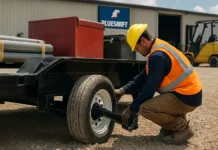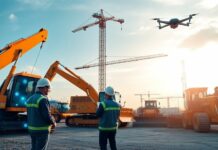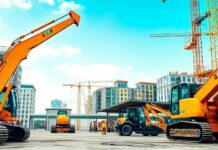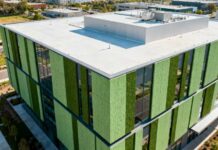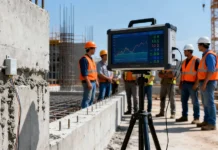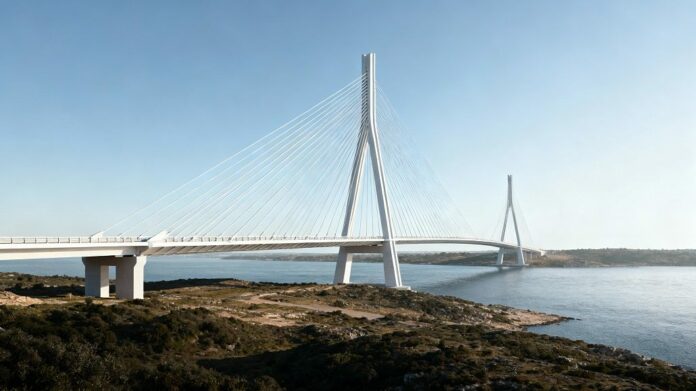Bridges represent some of humanity’s most ambitious engineering achievements—structures spanning vast distances while supporting extraordinary loads under dynamic and often harsh environmental conditions. Traditional bridge construction has relied upon steel and concrete—materials perfected over generations, understood thoroughly, and standardized extensively. Yet these conventional materials carry inherent limitations that increasingly constrain modern infrastructure development. Steel corrodes, requiring continuous protective maintenance. Concrete degrades when exposed to chloride-rich environments. Both materials prove heavy, requiring massive foundations and support structures. Both materials generate substantial carbon emissions during production.
Composite engineering in bridge construction represents a fundamental reimagining of how long-span infrastructure can be created, maintained, and sustained throughout decades of demanding service. Rather than incrementally improving conventional materials, composite bridges leverage engineered fiber-reinforced polymers delivering superior strength-to-weight ratios, permanent corrosion resistance, extended service life, and dramatically reduced maintenance requirements. These advantages transform bridge economics, environmental impact, and lifecycle sustainability.
Projects worldwide demonstrate that composite engineering enables bridge spans and performance impossible through conventional approaches while reducing environmental burden and lifecycle costs. A growing portfolio of successful implementations—from pedestrian bridges to vehicular crossings, from cable-stayed structures to arch bridges—proves that long-span infrastructure incorporating composites delivers on technical promise while establishing new standards for durability and sustainability.
Composite Materials: The Foundation of Modern Bridge Engineering
Composite bridges derive their distinctive capabilities from fiber-reinforced polymer materials combining reinforcing fibers with polymer matrices. Carbon fiber and glass fiber reinforcements embedded within epoxy or polyester resins create materials exhibiting mechanical properties dramatically exceeding individual component capabilities.
Material Properties Enabling Superior Bridge Performance
Carbon fiber reinforced polymers (CFRP) employed in bridge applications achieve tensile strength exceeding 600 megapascals while weighing approximately one-quarter of comparable steel. This dramatic strength-to-weight advantage enables bridge designs where lighter structures require smaller, less costly foundations while reducing overall structural material requirements by 30 to 40 percent compared to equivalent steel structures.
The specific strength—strength per unit weight—of CFRP proves particularly valuable for long-span applications where dead load (the structure’s own weight) dominates total loading. Traditional long-span bridges require massive support structures accommodating their own enormous weight. Bridge towers must be proportionally sized to support bridge deck dead load. Suspension cable sizing depends on bridge weight. Each design element must accommodate the structure’s inherent heft.
CFRP structures weighing 70 percent less than equivalent steel alternatives require proportionally smaller supports. Bridge towers can be slimmer. Suspension cables can be smaller. Foundations can be shallower. This cascading reduction in structural requirements ripples throughout design, reducing material volume, construction complexity, and costs simultaneously.
Corrosion Resistance and Extended Service Life
Traditional steel bridges require ongoing maintenance addressing rust formation. Bridge decks in climates with winter road salt experience accelerated corrosion. Steel supports in marine environments face corrosion challenges even with protective coatings. Protective paint systems require periodic renewal. Corroded steel sections require replacement. Annual maintenance costs frequently represent 5 to 10 percent of bridge construction costs throughout service life.
Composite engineering eliminates corrosion through fundamental material properties. Fiber-reinforced polymers exhibit permanent corrosion resistance deriving from their inherent chemical nature—fibers embedded in polymer matrices don’t oxidize or rust. Unlike protective coatings applied to steel requiring renewal, composite resistance proves permanent and maintenance-free.
This corrosion advantage proves particularly valuable for bridges in aggressive environments. Coastal bridges exposed to saltwater spray, bridges in regions employing winter road salt, and structures in chemically polluted environments all benefit from composite’s permanent durability. Lifecycle cost analysis frequently demonstrates that even premium composite material costs prove economically justified through reduced maintenance expenses accumulated over 50 to 100-year service lives.
The Foulk Road Bridge in Wilmington, Delaware, repaired with composite materials two decades ago, demonstrates this durability advantage. Long-term performance monitoring confirms that composite repairs maintain structural integrity and mechanical properties without requiring maintenance intervention over twenty years of service. Steel repairs comparable in age would likely require renewed protective treatment or potential replacement. The composite repair’s minimal maintenance requirement delivers direct economic benefit while establishing long-term cost advantage.
Lightweight Design Enabling Innovative Structural Forms
Composite materials’ light weight enables structural forms impossible with conventional materials. A pedestrian bridge created entirely from fiber-reinforced polymer weighs only a fraction of equivalent steel or concrete structures. This weight advantage enables:
Longer spans with shallower support structures, reducing excavation requirements and environmental disruption. Elegant slender tower designs providing superior aesthetics compared to massive conventional structures. Foundation simplification enabling construction in geographically constrained locations where conventional bridge approaches prove impractical.
The FRP Bridge in Solvesborg, Sweden, constructed entirely from fiber-reinforced polymer, demonstrates these possibilities. The lightweight bridge achieves elegant proportions impossible with conventional materials. The minimal environmental impact during construction, achieved through lightweight design reducing material requirements and disruption, establishes precedent for sustainable infrastructure development.
Cable-Stayed and Suspension Bridges: Advancing Long-Span Technology
Long-span bridges represent peak engineering achievements combining enormous technical challenge with dramatic visual presence. Composite engineering enables advances in long-span bridge design through materials delivering superior performance characteristics particularly valuable for spanning vast distances.
Carbon Fiber Composite Cables for Superior Performance
Cable-stayed bridges employ massive steel cables suspending bridge decks from tall towers. Traditionally, these cables consist of thousands of steel wires twisted together—a configuration perfected through generations of experience. Yet steel cables exhibit characteristics limiting long-span potential. Steel proves heavy, requiring enormous towers accommodating cable weight. Steel corrodes, requiring protective systems and periodic maintenance. Cable relaxation—slight dimensional changes under sustained load—occurs gradually over service life, requiring periodic tension readjustment.
Carbon fiber reinforced polymer cables offer dramatic advantages for long-span infrastructure. CFRP cables achieve tensile strength double that of equivalent steel cables while weighing one-third as much. This strength-to-weight advantage reduces tower requirements substantially. A cable-stayed bridge with CFRP cables might require towers 20 to 30 percent smaller than equivalent steel cable structures, reducing structural material requirements and cost while enabling longer spans.
CFRP cable research demonstrates superior performance across multiple dimensions. Tensile strength reaches approximately 1,500 megapascals—roughly double typical steel cable strength. Relaxation loss remains minimal—approximately one-half the relaxation exhibited by steel under equivalent loads. Environmental resistance proves absolute—CFRP cables resist salt spray, acidic environments, and temperature extremes without degradation.
The Yamanashi Maglev Test Line implemented CFRP cables for non-magnetic guide beam suspension. This application, where magnetic interference from steel cables could compromise maglev operation, demonstrates CFRP’s value for specialized applications. The cables maintained structural integrity without magnetic interference, enabling infrastructure functionality impossible with conventional materials.
Research into fatigue performance—the ability to withstand repeated loading cycles without progressive degradation—demonstrates that CFRP cables maintain mechanical properties through countless loading cycles exceeding conventional steel fatigue limits. This superior fatigue resistance ensures that CFRP cables experience minimal property degradation throughout service life despite dynamic loading from wind and traffic.
Bridge Design Innovation Through Material Advantages
Composite engineering in bridge construction enables design approaches advancing long-span capacity beyond conventional limitations. Researchers investigating CFRP cable-stayed bridges through numerical simulation and experimental testing confirm that composite materials enable span lengths 15 to 25 percent greater than equivalent conventional structures. These extended spans reduce the number of support locations required to cross vast distances, enabling infrastructure development in geographically challenging terrain.
The weight advantage of composite structures cascades throughout bridge systems. Lighter bridge decks require smaller supporting cables. Smaller cables require proportionally smaller towers. Smaller towers require more modest foundations. Each component reduction contributes to total infrastructure cost and environmental impact reduction. A comprehensive assessment of CFRP cable-stayed bridge compared to equivalent steel structure demonstrated 35 to 45 percent reduction in total material volume while improving structural performance.
Beyond technical performance, composite materials enable architectural designs reflecting contemporary aesthetic sensibilities. Lighter, more slender towers create visual elegance impossible with massive conventional structures. Designers gain freedom to explore forms previously constrained by material limitations. The resulting bridges prove not only technically superior but architecturally distinguished.
Rehabilitation and Repair Applications
The existing bridge inventory presents both challenges and opportunities for composite engineering implementation. Thousands of bridges worldwide exhibit damage, degradation, or capacity limitations requiring intervention. Conventional repair approaches involve massive disruption—removing damaged sections, replacing with new material, performing extensive reinforcement. Composite repair methods often provide less disruptive alternatives delivering superior long-term performance.
Externally Bonded Composites for Bridge Strengthening
A primary composite application in bridge rehabilitation involves bonding composite sheets or plates to concrete bridge surfaces, providing additional strength supporting increased loads or compensating for material degradation. The lightweight nature of composite reinforcement minimizes added dead load—unlike steel reinforcement adding substantial weight, composite reinforcement provides strength enhancement with minimal structural burden.
A concrete bridge requiring capacity increase to accommodate modern traffic loads might be strengthened through externally bonded carbon fiber composite sheets. The process involves surface preparation, adhesive application, and composite attachment. Upon completion, the bridge exhibits increased load capacity without massive structural modifications. The minimal disruption enables bridge functionality continuation throughout the repair process.
Carbon fiber reinforced polymer reinforcement applied externally to concrete structures has demonstrated long-term durability exceeding two decades in field deployments. The Foulk Road Bridge in Delaware, strengthened with CFRP reinforcement over twenty years ago, continues to exhibit superior structural performance without degradation. Mechanical testing of extracted samples confirms that composite reinforcement maintains mechanical properties despite two decades of environmental exposure and service loading.
Corrosion-Resistant Rebar for New Construction and Replacement
Beyond external reinforcement, composite rebar provides permanent alternative to steel reinforcement subject to corrosion in aggressive environments. Fiber-reinforced polymer rebar exhibits mechanical properties comparable to steel rebar while eliminating corrosion concerns. A concrete bridge deck constructed with composite rebar in a coastal environment would experience dramatically extended service life without developing the rust-related deterioration characteristic of conventional reinforced concrete.
Glass fiber reinforced polymer (GFRP) rebar provides cost-effective alternative to carbon fiber reinforcement, offering adequate strength at reduced material cost. GFRP rebar applications in marine infrastructure where corrosion represents primary degradation mechanism demonstrate extended service life compared to conventional reinforced concrete experiencing progressive corrosion-related damage.
Environmental and Sustainability Considerations
Composite engineering delivers sustainability benefits extending beyond operational performance into comprehensive lifecycle environmental impact.
Reduced Carbon Footprint Through Lightweighting
Bridge mass fundamentally influences lifecycle carbon emissions. Lighter structures require less material, generating fewer production emissions. Lighter structures demand smaller foundations, reducing excavation and concrete requirements. Lighter bridge decks enable smaller cable systems, further reducing material volume.
A comprehensive lifecycle assessment comparing CFRP cable-stayed bridge to equivalent steel structure demonstrated 25 to 35 percent lower total embodied carbon. While CFRP production generates somewhat higher carbon intensity per kilogram compared to steel production, the dramatic weight reduction more than compensates. A bridge weighing 60 percent of equivalent conventional structure generates substantially lower embodied carbon despite less-favorable unit production emissions.
Extended Service Life Reducing Replacement Requirements
Durability improvements enabled by composite materials reduce long-term environmental impact through extended service life. A bridge requiring replacement every 50 years accumulates environmental costs associated with complete demolition and replacement twice across a 100-year analysis period. A composite bridge maintaining functionality throughout a 100-year period requires only initial construction environmental expenditure, generating substantially lower cumulative impact.
Research demonstrating CFRP durability over 20-year field deployment periods suggests that 50-year service lives represent conservative estimates. Some researchers project potential service lives exceeding 100 years, particularly for well-designed structures in controlled environments. If realized, such extended service life would generate environmental benefits accumulating substantially over infrastructure lifetime.
Reduced Maintenance Environmental Impact
Annual bridge maintenance generates direct environmental costs through material consumption (protective coatings, replacement sections) and energy consumption (maintenance equipment, transportation). A bridge requiring minimal maintenance throughout service life generates substantially lower cumulative environmental impact compared to structure requiring ongoing corrective intervention.
CFRP bridges demonstrating minimal maintenance requirements throughout service life generate environmental benefit accumulating annually. This operational advantage, combined with reduced production embodied carbon and extended service life, creates comprehensive sustainability profile where composite structures prove environmentally superior across complete lifecycle.
Economic Analysis and Lifecycle Costs
While composite materials frequently command premium pricing compared to conventional alternatives, comprehensive lifecycle cost analysis often reveals economic advantage through operational cost reduction and extended service life.
Initial Capital Costs vs. Long-Term Savings
A bridge constructed from composite materials might involve 15 to 25 percent higher initial material costs compared to equivalent conventional construction. However, weight reduction enables foundation cost savings of 10 to 20 percent. Reduced labor requirements for installation and assembly provide additional cost offset. These factors frequently narrow or eliminate initial cost disadvantages.
Beyond initial capital costs, operational advantage emerges through maintenance cost elimination. A conventional steel bridge might require $50,000 to $100,000 annually in protective maintenance. A composite bridge requires minimal maintenance beyond routine cleaning, potentially reducing annual operational costs by 90 percent. Accumulated over 50-year bridge life, this annual maintenance saving generates enormous cumulative economic benefit.
Cost of Delayed Failure vs. Preventive Maintenance
Traditional bridge maintenance approaches employ “run to failure”—structures receive minimal intervention until deterioration becomes evident, then receive corrective repair or replacement. This approach frequently proves economically suboptimal. Unexpected bridge failures create enormous costs—emergency repair or replacement, traffic disruption, potential safety consequences.
Composite durability prevents failure occurrence, eliminating unplanned failure costs while providing operational reliability enabling confident long-term planning. Bridge operators can schedule maintenance interventions systematically rather than responding to emergencies.
Real-World Success Stories and Emerging Projects
Diverse projects worldwide demonstrate composite engineering capabilities across bridge applications.
Beddington Trail Bridge: Corrosion-Resistant Solution
The Beddington Trail Bridge in Canada, reconstructed using CFRP cables and reinforcement, exemplifies how composite engineering solves severe corrosion challenges. Operating in a coastal environment with winter road salt, the bridge previously experienced rapid deterioration from chloride-induced corrosion. CFRP reconstruction provided permanent corrosion resistance eliminating future deterioration concerns. Long-term monitoring confirms superior performance compared to conventional structures in identical environments.
Pedestrian Bridge Innovations
Lightweight composite pedestrian bridges deployed globally demonstrate design freedom enabled by composite materials. These structures often exceed conventional bridge elegance through slender profiles and innovative structural forms impossible with heavy conventional materials. Projects including the Limmat River Pedestrian Bridge and other installations demonstrate that composites enable simultaneous achievement of technical excellence, aesthetic distinction, and environmental sustainability.
Future Directions and Emerging Technologies
Composite engineering continues advancing through novel reinforcement materials, innovative manufacturing processes, and design optimization approaches.
Hybrid structures combining composites with other materials—concrete, steel—leverage advantages of each material in locations maximizing their contribution. Composite towers coupled with concrete bridge decks create hybrid systems optimizing performance across bridge components.
Three-dimensional printing of composite structures enables geometric optimization impossible through conventional manufacturing. Topology optimization algorithms discover optimal material distributions minimizing weight while maintaining structural adequacy. 3D-printed composite bridge components promise structures incorporating material only where required structurally, minimizing embodied carbon while maximizing performance.
Self-healing composites incorporating microencapsulated healing agents represent emerging capability potentially extending service life beyond current projections. Should crack development occur, embedded healing agents activate automatically sealing damage before propagation into structural compromise.
Conclusion: The Next Generation of Bridge Infrastructure
Bridges of the future will increasingly incorporate composite engineering delivering superior performance, reduced environmental impact, and enhanced durability compared to conventional approaches. The convergence of technical advancement, environmental imperative, and economic advantage creates compelling rationale for broader composite adoption in bridge infrastructure.
For infrastructure owners, engineers, and planners responsible for bridge development and maintenance, composite engineering in bridge construction represents essential capability enabling infrastructure meeting contemporary performance and sustainability expectations. The evidence from successful deployments worldwide demonstrates that composite bridges deliver on technical promise while establishing new standards for durability, maintainability, and environmental responsibility.
As composite technology continues maturing and construction industry expertise develops, long-span infrastructure increasingly will leverage composite materials capturing technical advantages and sustainability benefits these materials uniquely enable. Organizations positioned today to understand and deploy composite engineering will lead the evolution toward infrastructure generation delivering exceptional performance, sustainability, and economic efficiency.





